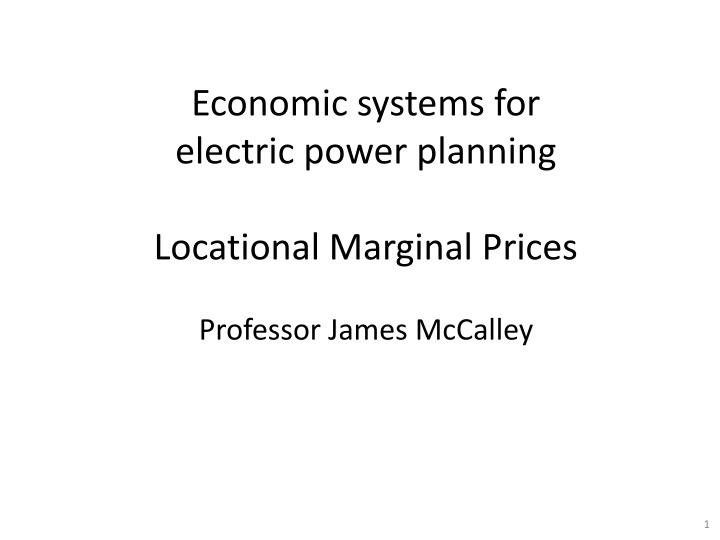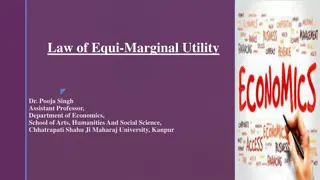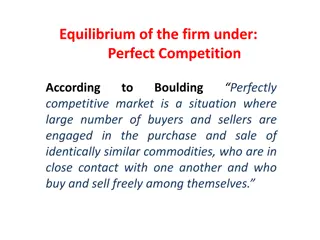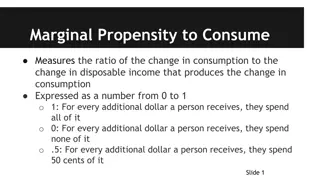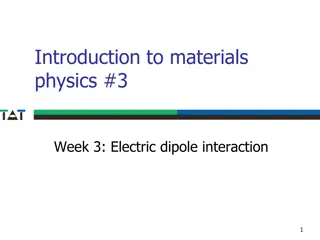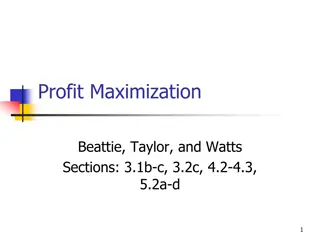Economic Systems for Electric Power Planning: Overview of Locational Marginal Prices
Explore the formulation of Locational Marginal Prices (LMPs) in power systems, including power balance equations and line flow constraints. Understand the breakdown of LMP and its components through optimization problems and the Envelope Theorem.
Download Presentation

Please find below an Image/Link to download the presentation.
The content on the website is provided AS IS for your information and personal use only. It may not be sold, licensed, or shared on other websites without obtaining consent from the author.If you encounter any issues during the download, it is possible that the publisher has removed the file from their server.
You are allowed to download the files provided on this website for personal or commercial use, subject to the condition that they are used lawfully. All files are the property of their respective owners.
The content on the website is provided AS IS for your information and personal use only. It may not be sold, licensed, or shared on other websites without obtaining consent from the author.
E N D
Presentation Transcript
Economic systems for electric power planning Locational Marginal Prices Professor James McCalley 1
Overview of LMPs In the LPOPF without demand bidding, we saw that locational marginal price (LMP) at bus k gives the cost to the system of supplying one more MW of demand at bus k. Here, we provide a formulation of the LPOPF, but this time we include losses in the power balance equation. Our goal is to see if we can break down the LMP into a set of individual components, to see what its made of, so-to- speak. 2
Overview of LMPs min ( ) g f P N = s P Objective: k gk = 1 k Subject to: N = Power balance: P P loss P gk dk = 1 k N = Line flow constraints: = ( ) , ,..., 1 t P P F j M In CPLEX, we should enter these constraints as : N F t P = max jk gk dk j 1 k = ( ) , 1,..., P F j M max max j jk gk dk j 1 k Here, however, we want simplicity. Doing so does not prevent bidirectional flows; it merely enables us to be concerned with reaching the upper bound in only one direction. Lagrangian: N N M N = k = k = j = k = ( , , ) ( ) L P s P P P loss P t P P F max k gk gk dk j jk gk dk j g 1 1 1 1 3
Overview of LMPs Lagrangian: N N M N , , ) = ( ( ) L P s P P P loss P t P P F g max k gk gk dk j jk gk dk j = = = = 1 1 1 1 k k j k First-order conditions: L P ( , , ) P loss P P M g = = : (1 ) 0 k gen s j jk t k = 1 j gk gk But we are more interested in the load buses: ( , , ) : k load P And we are interested in making this evaluation at the optimum: ( , , ) : k load P L P loss P P M g = + + (1 ) j jk t (17a) = 1 j dk dk L P loss P P M g = + + (1 ) j jk t (17b) = 1 j dk dk * G * G P P Note that Pdk is not a decision variable, and therefore we do not set the Lagrangian derivative wrspt it equal to 0. So what is this thing , i.e., the derivative wrspt Pdk? * G L dk P P 4
Envelope Theorem Consider the following optimization problem. max ( , ) x st g x where x is the decision variable; and is some parameter that is influential in the problem, but it is not a decision variable, i.e., we may not select its value. We desire to find how the optimal value of f changes with respect to . f x (18) = . . ( , ) 0, ( , ) h x 0 Let s give a name to the optimal value of f. Let s call it V; it is a function of . That is, ( * ( ) ( x f V = Then what we are trying to find is Note (from (19)): V will change both because affects f and because it also affects the optimal choice of x (denoted as x*). ), ) (19) ( ) V (20) 5
Envelope Theorem ( , , , ) L x = ( , ) h x ( , ) g x ( , ) f x (21) And recall (from (19)): V = ( ) ( * ( ), ) f x How does optimal value of f, denoted V, change with ? That is, ( ) ? It is important to understand what V is, and what it is not. V ( *( ), ) f x = OR = ? It is not f, i.e., it is not our objective function. It is the optimal value of our objective function. It is the value of our objective function when x is chosen to be x*. The process of choosing x to be x* is the process of solving the optimization problem. So V is a function that includes this process. This means that V/ finds how a change in affects f(x*) (and not just f(x); in other words, V/ differentiates thru this process . 6
Envelope Theorem Envelope theorem: The total rate of change in the optimal value of the objective function due to a small change in the parameter is the rate of change in the Lagrangian L evaluated at the optimal value of x. That is, ( ( ) ( x L V The proof requires several lines of calculus that we omit here. ), , ) = (22) = * x x 7
Locational Marginal Price Armed with the envelope theorem, we may now identify the meaning to (17), which is repeated here for convenience: ( , , ) : (1 k load P L P loss P P M g = + + ) j jk t (17b) = 1 j dk dk * G * G P P The envelope theorem enables us to interpret the meaning of (17b). ( ) ( ( ), , ) V L x = Then these are the same! = * x x These are the same! L P ( , , ) P loss P P M g = + + : (1 ) k load j jk t = 1 j dk dk * G * G P P Implication is that the RHS of (17b) expresses the rate of change in the optimal value of our objective function for a unit change in Pdk. Thus, the envelope theorem provides a clear understanding, and a theoretic basis, for locational marginal prices (LMPs). 8
Locational Marginal Price In other words, if we solve the optimization problem with Pdk=Pdk0, obtaining f*(Pdk0), and then resolve the optimization problem with Pdk=Pdk0+1, obtaining f*(Pdk0+1), then L P ( , , ) P g + = *( 1) *( ) f P f P (23) 0 0 dk dk dk * G P L P ( , , ) P g We call the LMP for bus k, that is, dk * G P M P = j loss P = + + : 1 ( ) k load LMP t (24) k j jk 1 dk Written slightly different, it is M P = j loss P = + + : k load LMP t (25) k j jk 1 dk 9
Locational Marginal Price And (25) show us a very useful way to think about LMPs. They consist of three components: = : Energy component P P k load LMP k + loss Loss component dk M + Congestion component j jk t = 1 j You may gain additional insight into each of the above terms by reading my notes Understanding LMPs, which can be downloaded from the website. 10
